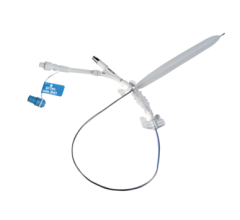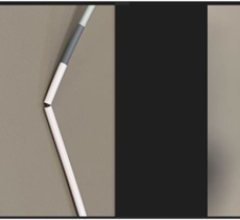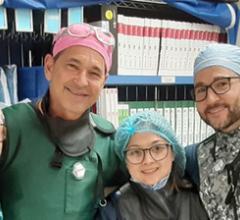
January 25, 2012 — Physicians at University Hospitals (UH) Case Medical Center enrolled their first patient in LEVANT 2, a global, multicenter, randomized clinical trial evaluating the safety and efficacy of the Moxy drug-coated balloon for the treatment of peripheral arterial disease (PAD).
Co-investigators Sahil Parkih, M.D., Michael Cunningham M.D., and Vikram Kashyap, M.D., with UH Harrington-McLaughlin Heart and Vascular Institute at UH Case Medical Center were the first physicians to successfully implant the device in a patient.
LEVANT 2, sponsored by medical device manufacturer Lutonix Inc. is the first drug-coated balloon pivotal trial to be approved by the U.S. Food and Drug Administration (FDA). UH Case Medical Center is one of 55 centers around the world participating in the trial, which is expected to randomize 476 patients with diseased femoropopliteal leg arteries.
The trial will investigate whether the Moxy balloon is more effective than standard angioplasty at keeping leg arteries open and free from re-blockage over time.
“The drug coated balloon is a novel approach for treating PAD – traditional therapies required bypass surgery, but as minimally invasive techniques have evolved, we have been able to offer procedures such as angioplasty and stent placement in the legs,” said Parikh, a cardiovascular medicine specialist with UH Case Medical Center, and assistant professor at Case Western Reserve University School of Medicine. “The problem has been that these treatments have been hampered by renarrowing due to the in-growth of scar tissue into the arteries known as restenosis.”
According to Parikh, the latest drug-coating technology for balloons was adapted from concepts applied to medicated stents during heart catheterizations.
“The advantage of a drug-coated balloon is that it does not require the placement of a stent to be effective, and we believe, will prove to be an excellent alternative therapy to surgical bypass, especially points of flexion in the leg or at the knee, where placement of a metal stent would possibly lead to ultimate fracture of the stent,” Parikh said.
LEVANT 2 is the largest randomized peripheral drug-coated balloon clinical trial to date, and one of the largest peripheral vascular studies ever conducted. Currently, University Hospitals ranks as the highest-enrolling site in the region as well as among the top 10 in the world.
Randomized patients in LEVANT 2 will be followed for a total of five years and independent core laboratories will be utilized to verify trial outcomes. The primary safety endpoint is a composite of freedom from all-cause peri-operative death and freedom at one year from amputation, re-intervention and death. The primary efficacy endpoint is primary patency at one year.
Drug-coated balloons are similar to standard angioplasty balloons except they are coated with an anti-restenotic drug aimed at preventing the artery from becoming blocked again. During the procedure, the Moxy balloon is inserted inside the narrowed area of the artery and then inflated to open the blockage and deliver the drug to the artery. After this short inflation, the balloon is removed from the body, leaving nothing but the drug behind in the artery.
LEVANT 2 is a follow-on trial to LEVANT 1, which was a 101-patient multicenter randomized trial. Patients either received the Moxy balloon or standard angioplasty for the treatment of diseased femoropopliteal arteries. Based on the success and positive results of the LEVANT 1 trial, LEVANT 2 was designed to investigate the device in a larger patient population.
For more information: www.uhhospitals.org


 June 13, 2024
June 13, 2024 








